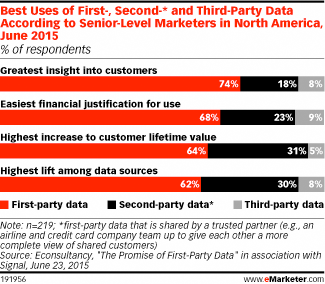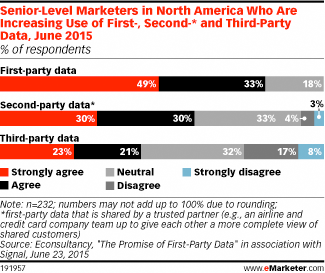Marketers Put First-Party Data First
June 30, 2015
![]() Despite struggles, marketers remain focused on improving big data, and those putting money toward such efforts are reaping the benefits. In April 2015 research by the Direct Marketing Association and Winterberry Group, 43% of US marketing professionals said they expected their data-driven marketing (DDM) spending to be higher in Q2 2015 than Q1, and 60.2% of respondents expected DDM revenues to increase during the same period.
Despite struggles, marketers remain focused on improving big data, and those putting money toward such efforts are reaping the benefits. In April 2015 research by the Direct Marketing Association and Winterberry Group, 43% of US marketing professionals said they expected their data-driven marketing (DDM) spending to be higher in Q2 2015 than Q1, and 60.2% of respondents expected DDM revenues to increase during the same period.
 However, June 2015 research by Econsultancy in association with Signal found that senior-level marketers in North America weren’t jumping for joy over returns from data-related marketing investments. Just over one-third said these had a strong positive impact. Promisingly, though, was that 47% said that they had some positive impact.
However, June 2015 research by Econsultancy in association with Signal found that senior-level marketers in North America weren’t jumping for joy over returns from data-related marketing investments. Just over one-third said these had a strong positive impact. Promisingly, though, was that 47% said that they had some positive impact.
Econsultancy suggested that first-party data could help the group reporting so-so results—along with the laggards, of course. When marketers were asked to compare different levels of data and their effect on desired outcomes, first-party data ranked highest across the board. It was most popular for gaining insight into customers, cited by 74% of respondents. More than six in 10 respondents also said it was the easiest to justify using, drove the highest increase in customer value and the highest campaign lift among data sources—all by a long shot.
 January 2015 study by Forrester Consulting, commissioned by Adroit Digital, found that while first-party data had to be accompanied by second- and third-party information, it was still the most important source—cited by 87% of US digital marketers and customer insights professionals when asked about their attitudes toward the use of data at their companies.
January 2015 study by Forrester Consulting, commissioned by Adroit Digital, found that while first-party data had to be accompanied by second- and third-party information, it was still the most important source—cited by 87% of US digital marketers and customer insights professionals when asked about their attitudes toward the use of data at their companies.
It makes sense, then, that Econsultancy respondents were most likely to plan on increasing usage of first-party data, with 49% of marketers strongly agreeing they would do so and an additional 33% agreeing. Six in 10 did plan to increase second-party data usage as well, while fewer than half said the same about third-party information.
The study found that first-party data sources would be most important to respondents’ strategy moving forward. Transaction history (87%), customer information (80%) and behavioral data (74%) were the most-cited data types. Info from trusted partners—that is, second-party data—landed in the middle of the list, at 60%, with third-party behavioral, customer and demographic data at the bottom, each cited by around half of respondents.
Courtesy of eMarketer




























